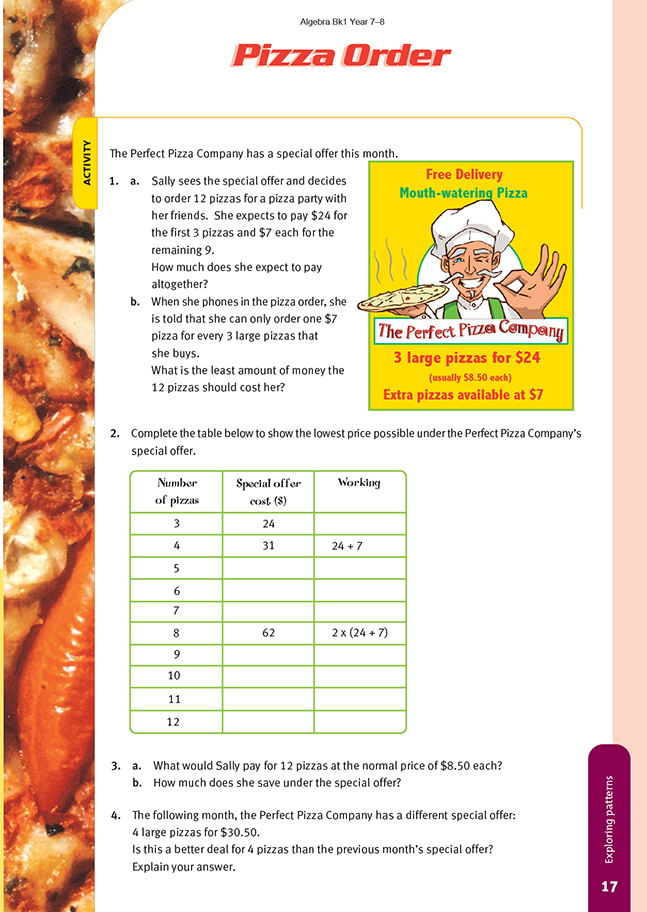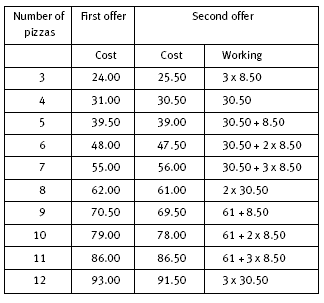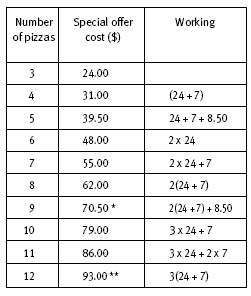This is a level 3 algebra strand link activity from the Figure It Out series.
A PDF of the student activity is included.
Click on the image to enlarge it. Click again to close. Download PDF (215 KB)
use a table to compete a pattern
FIO, Link, Algebra, Book One, Pizza Order, page 17
This activity asks students to combine regular prices and special deals in order to calculate the total cost for an order of pizzas.
In question 1, Sally thinks (reasonably) that the first 3 pizzas will cost $24 and that the cost of each subsequent pizza in her order is $7. The total cost is then $24 + 9 x $7 = $24 + $63 = $87. However, it turns out that Sally has misunderstood the special offer. The total offer is for sets of 4 pizzas where each set of 4 pizzas
costs a total of $24 + $7 = $31. This means that 12 pizzas will actually cost 3 x $31 = $93, not $87 as Sally had first thought.
In question 2, the students complete the table so they can see how to calculate the cost of any number of pizzas.
There are two ways that the offer could be used to calculate the cost of 9 pizzas and also of 10 and 12 pizzas. Firstly, 9 pizzas could be charged as 2 sets of 4 pizzas and 1 additional pizza. The cost for this is (2 x $31) + $8.50 = $70.50. An alternative is to charge for 3 sets of 3 pizzas costing 3 x $24 = $72. So the first charging method is the cheaper for 9 pizzas. The situation is similar for 12 pizzas. Here, it is cheaper
to pay for 3 sets of 4 pizzas (3 x $31 = $93) than for 4 sets of 3 pizzas (4 x $24 = $96). For 10 pizzas, the offer could be used to buy 2 sets of 4 pizzas at $31 per set, plus 2 pizzas at $8.50 each, for a total of $79. Alternatively, the offer could be used to buy 3 sets of 3 pizzas at $24 per set, plus 1 pizza at $7, for a total of $79. In this example, both approaches give the same total price. More able students could examine charging possibilities for other numbers of pizzas to see if there are acceptable alternatives.
In question 4, the students examine a new offer. Under the initial offer, 4 pizzas cost $24 + 7 = $31. Now the cost is $30.50, which is a saving of 50 cents. The students could extend the table they made for question 2 earlier to further compare prices under the two offers:
Note that the second offer is the cheaper for all except 3, 7, or 11 pizzas. By extending the table to 15 pizzas, the students might explore to see if this pattern continues to jump in fours.
Answers to Activity
1. a. $87.00 (24 + 9 x 7 = 87)
b. $93.00 (3 lots of 4 pizzas, where each lot is 3 for $24 and 1 at $7. Note that this is $3 cheaper than buying 4 lots of 3 pizzas at $24.)
2.
* Note that this is cheaper than 3 x 24 = $72.
** Note that this is cheaper than 4 x 24 = $96.
3. a. $102.00
b. $9.00
4. Yes. The cost of 4 pizzas under the previous offer was $31 (from $24 + $7), whereas 4 pizzas under the new offer cost $30.50, a saving of 50 cents.


